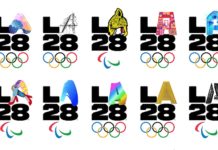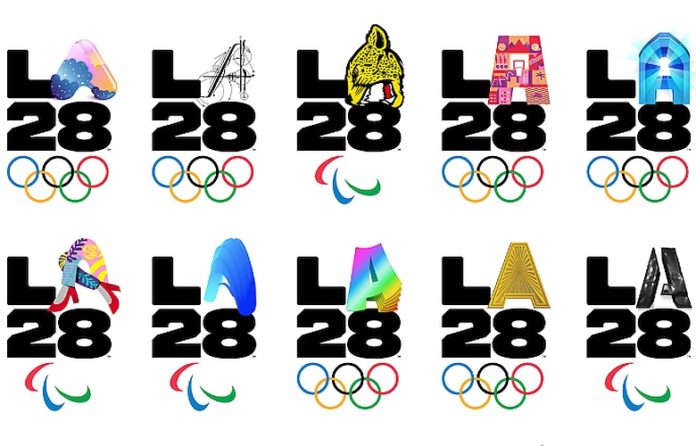★ The Sports Examiner: Chronicling the key competitive, economic and political forces shaping elite sport and the Olympic Movement.★
★ To get The Sports Examiner by e-mail: sign up here! ★
★ Friends: Thrilled! Our 21 donors have covered 50.9% of our technical costs for the rest of 2024. If you can support our coverage, please donate here. Your enthusiasm is the reason this site continues. ★
Amid the excitement of multiple U.S. Olympic Trials taking place across the country and Friday’s major announcement of changes in the designated venues for 10 sports for the 2028 Olympic Games came a report to the Los Angeles City Council: the annual report of the LA28 organizing committee.
For those watching the finances and worried – because worrying about money is something many people do – the key paragraphs of the LA28 report narrative were these:
“LA28’s financial health is reflected on the Statement of Financial Position with an ending cash balance of $65.4M million at the end of 2022.
“On the Statement of Activities, revenue in 2022 is $55.2M offset by $142.6M expenses, which results in an annual deficit of $87.4M. The total cumulative deficit is $233.1M. In accordance with generally accepted accounting principles (GAAP), LA28 is required to defer the recognition of significant revenues received ($298.3M through 2022) until the contractual obligations can be performed (e.g. activation of sponsorship and licensing rights at a future date). As deferred revenue becomes recognized in future years, it will offset the current reported deficit.”
Kind of dismal today, hopeful tomorrow, right? The report also added that “LA28’s operating reserves remain healthy due to payments received from domestic sponsorships and licensing partners totaling $175 million.”
The report includes audited financial statements for 2022, which are not of much help, looking at what the status was 18 months ago. But, in the 2023 annual report, LA28 included a new chart tracking cash flow, which provides a limited look at what has been going on. With a second chart in the 2024 report, we can see some interesting comparative results:
Revenues:
● $121.6 million forecast for 2022
● $121.6 million actual in 2022 (variance: 0)
● $181.7 million forecast for 2023
● $179.3 million actual in 2023 (variance: -$2.3 million)
Expenses:
● $137.6 million forecast for 2022
● $138.3 million actual in 2023 (variance: +0.7 million)
● $189.2 million forecast for 2023
● $139.0 million actual for 2023 (variance: -$50.2 million)
The overall budget of $6.884 billion has not changed; LA28 promises a revised budget by the end of 2024. Thus, the numbers for 2025-28 have simply been recalculated to match the existing bottom lines.
But the $50.2 million reduction in expenses for 2023 vs. projections is a good sign. LA28 was told early and often after winning the bid in 2017 to keep spending as low as possible through 2024, because it will have to spend a lot starting n 2025.
That was good advice and the organizing committee listened. Its tax return (IRS Form 990) reported 126 employees at the end of 2022, up from 87 at the end of 2021. That number is a little more than 180 now, as reported in April 2024 at the Association of Summer Olympic International Federations (ASOIF) General Assembly.
That’s not nothing, but it is limited staffing – which includes the full-on sponsorship sales effort – and very few department heads for the major functional areas have been hired and most have not been staffed at all. That will begin to change after the Paris Games conclude. Personnel costs of $34.46 million in 2022 was by far the largest expense item.
Encouragingly, LA28’s revenue streams from sponsorships and licensing have began in earnest:
● $19.11 million in 2021 sponsorship revenue
● $39.52 million in 2022 sponsorship revenue (2.07x)
● $1.39 million in 2021 licensing revenue
● $7.47 million in 2022 licensing revenue (5.37x)
It should also be noted that LA28 is the operator of the joint venture between it and the U.S. Olympic and Paralympic Committee, and is paying $58.0 million per year in quarterly transfers to the USOPC through 2028 (the annual amount will increase to $64.0 million in 2025) with a total amount of $476.1 million. These payments are shown on the LA28 financials as expenses, and were 66.4% of the 2022 deficit.
There are clouds on the horizon, however.
The Host City Contract between LA28 and the International Olympic Committee, signed in 2017, promises payments of $898 million as LA28’s share of the IOC’s television rights sales for the 2028 and a share of the IOC’s sponsorship program (known as TOP). This amount is flexible and not guaranteed:
“for indicative purposes only, based on the experience of the IOC from previous editions of the Games of the Olympiad and without taking into account potential evolutions in the International Programme that may occur after the execution of the HCC (including, without limitation, potential renegotiations or renewals of current agreements covering key product categories which are forecasted to generate an estimated increase of USD 200.000.000 (two hundred million United States dollars) in the amount indicated below), the amount of the OCOG’s share of the net revenues (including cash and value-in-kind) from the International Programme foreseen under §8.1(e), is currently estimated at USD 437.000.000 (four hundred thirty seven million United States dollars).”
It has been widely reported that Toyota, the IOC’s mobility sponsor, will not renew after the Paris Games conclude, which could end up impacting the amount LA28 will receive. And there are worries that the TOP program from 2025-28 will not sign as many partners as from 2021-24 (15). But, following the language of the agreement, the LA28 budget shows $637 million in IOC transfers on sponsorship.
LA28 lost one of its early sponsors, Salesforce, in April, possibly the first time a signed commercial partner had pulled out of a Games. A sponsorship with Cisco was recently announced and more agreements are promised post-Paris; whether the $2.5 billion budget target for the domestic sponsorship program can be met has been questioned.
Those are worries.
¶
Against this backdrop came Friday’s first announcement of venue changes, moving all or part of 10 sports to different locations. In short:
● Aquatics: Swimming from USC’s Dedeaux Field to SoFi Stadium, diving to the John C. Argue Swim Stadium next to the Coliseum and artistic swimming to Long Beach, paired with water polo.
● Archery, BMX cycling (racing and Freestyle) and skateboarding to the Sepulveda Basin Recreation Area.
● Basketball from Crypto.com Arena in Los Angeles to the new Intuit Dome in Inglewood.
● Equestrian to Galway Downs in Temecula, instead of the Sepulveda Basin.
● Gymnastics from The Forum to Crypto.com Arena.
● Shooting to a facility outside of the City of Los Angeles, instead of the Sepulveda Basin.
● Softball and canoe slalom to existing, world-class venues in Oklahoma City, Oklahoma.
The LA28 plan concept was to minimize venue infrastructure conversion costs, and arrange for more seating for popular sports, such as by moving swimming to SoFi Stadium. Its calculations showed a positive financial impact of $156 million from these changes, all to the good.
In order to make the schedule work for SoFi Stadium, already the site for the opening ceremonies on 14 July 2028, the swimming events will be pushed to the second week of the Games for the first time since 1968 in Mexico City. That will bring track & field to the first week for the first time in 60 years, enthusiastically embraced by World Athletics chief Sebastian Coe (GBR): “By prioritising athletics in the first week, the Games will witness the most thrilling of starts, captivating audiences worldwide and setting the stage for an unforgettable Olympic journey for global audiences.”
He should be happy. In the U.S., television ratings typically sag in the second week, impacting the audience for track & field; it won’t have that problem in 2028.
The changes to the events to be held in the Sepulveda Basin Recreation Area are especially welcome, as equestrian, shooting and canoe slalom were terrible, expensive mismatches for the space, with excellent – less costly, easier to install and remove and more fun to watch – replacements in archery, cycling BMX and skateboarding. All three of these sports already use open spaces and convert them for competition, then return them to their original state. Perfect.
And there are more changes coming:
● Canoe Sprint and Rowing are already contracted for the Long Beach Marine Stadium, site of the 1932 Olympic Games rowing competitions, but have not been officially announced.
● UCLA’s Pauley Pavilion was designated as the site for judo and wrestling, but will now be used for training as part of the Olympic Village. So, they need to be moved; The Forum is now available and is well set up for these mat sports.
● Modern Pentathlon is in transition, dropping riding in favor of an obstacle course and the fencing segment is being trimmed. Originally sited at the Dignity Health Sports Park – along with field hockey, rugby sevens, tennis and track cycling – it is likely to move elsewhere.
● Skateboarding is now on the way to the Sepulveda Basin, but no sites have been announced for sport climbing or surfing. LA28 Chair Casey Wasserman indicated in a radio interview that surfing would be at Huntington Beach or the Trestles in San Clemente, California.
● Of the added sports requested by LA28, baseball will be at Dodger Stadium and softball in Oklahoma City, with sites to be announced for cricket, flag football, lacrosse and squash.
These kinds of venue moves are quite normal for Olympic organizing committees and LA28 had said nothing about venues for seven years.
What is promising is the commitment by LA28 to its “no-build” philosophy, which is the key to ensuring that the Games project has a surplus at the end. At the Los Angeles Olympic Organizing Committee for the 1984 Games, committee chief Peter Ueberroth told anyone who would listen that a review of past Games showed that organizing committees always had a surplus of revenues over operating costs; it was construction that caused deficits.
LA28 is – to its credit – rigidly maintaining that stance, and now has a partner in the IOC, which scoffed at the LAOOC plan 40 years ago. Not so today.
As more venues come on line – possibly the expansion of the Los Angeles Convention Center, still under discussion by the City – LA28 could pivot again to take advantage of facilities already built and in many cases, with existing operators.
Ueberroth preached thrift, internal and external communications with stakeholders to maintain confidence and flexibility as keys to success in the organization of the 1984 Games, which ended with a first-ever Olympic Games surplus of $232.5 million. If LA28 can maintain its current path, and with some luck, it can do as well, or perhaps much, much better.
Rich Perelman
Editor
You can receive our exclusive TSX Report by e-mail by clicking here. You can also refer a friend by clicking here, and can donate here to keep this site going.
For our updated, 547-event International Sports Calendar for the rest of 2024 and beyond, by date and by sport, click here!



















